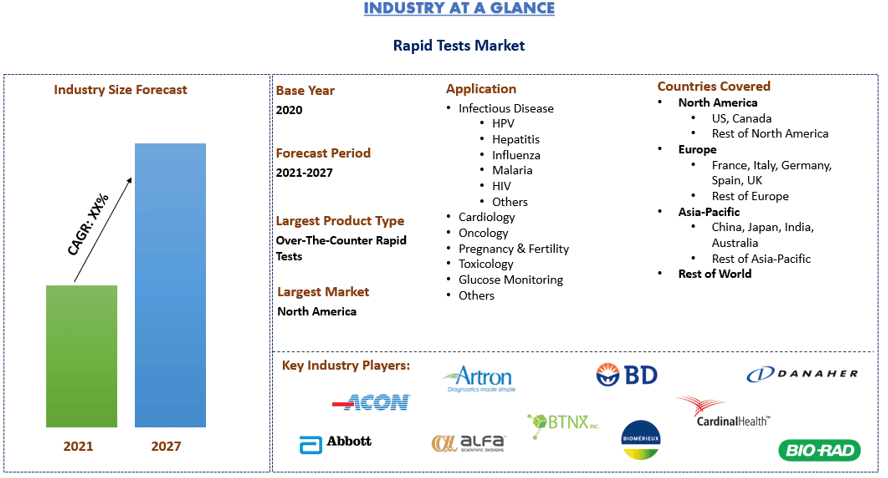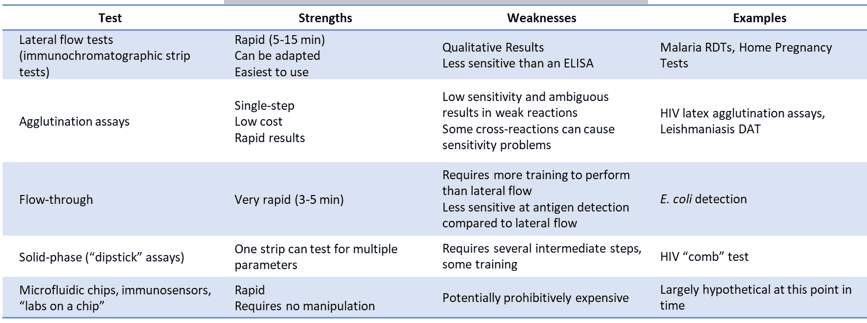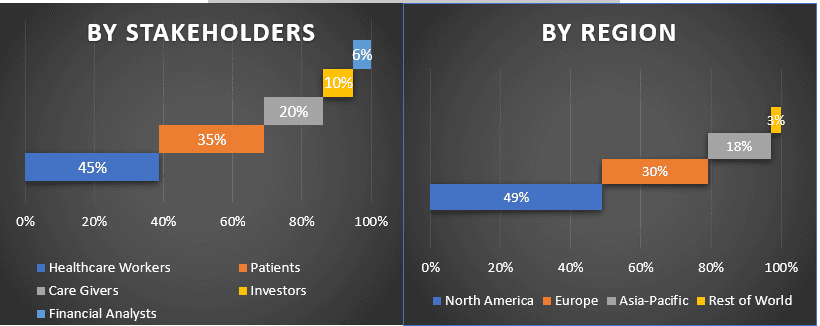- Home
- About Us
- Industry
- Services
- Reading
- Contact Us
Rapid Tests Market: Current Analysis and Forecast (2021-2027)
Emphasis on Product Type (Over the counter (OTC) Rapid Test Product, and Professional Rapid Test Product); Application (Infectious Disease, Cardiology, Oncology, Pregnancy & Fertility, Toxicology, Glucose Monitoring, and Others); End-User (Hospital & Clinic, Diagnostic Laboratory, Home Care, Others); and Region & Country.
Rapid Tests Market was valued at ~US$ 20 billion in 2020 and is expected to grow at a CAGR of ~9% over the forecast period (2021-2027). Rapid tests are parasite-based diagnosis tests in cases where microscopy is not possible. These tests are designed to be used in point-of-care (POC) and are adapted for use in low-resource setting. Rapid tests are low-cost, simple to use, specific, sensitive, stable and stable and high temperatures. These tests are being used for a variety of diseases. Rapid Tests can be used in settings with minimally trained healthcare professionals, additionally, the samples can be collected non-invasively or with low invasion such as blood extraction from capillaries. There are a variety of platforms for rapid tests, each with their own benefits and limitations.
Key factors influencing the market growth include, increasing awareness among people, increasing prevalence of infectious disease and the gaining popularity of high accuracy, low-cost rapid tests. Additionally, the promotion of personalized care and tests approach by rapid tests manufacturers is also booming the rapid tests market. Furthermore, the WHO, the CDC and the European Centre for Disease Prevention and Control are engaged in mapping prevalence and incidence of infectious diseases around the world. The most common infectious diseases are respiratory infections and tuberculosis which are 43% prevalence of all the infectious diseases and HIV/AIDS and sexually transmitted infections with 26% prevalence. Drawbacks to the market include stringent government regulations and recalling several products due to false results. The recent Covid-19 rapid test kits have also increased their popularity. All these development are boosting the growth of the rapid tests market.
Strengths and Weaknesses of Common Rapid Tests, 2020
ACON Laboratories, Inc., Abbott Laboratories, Artron Laboratories Inc., Alfa Scientific Designs, Inc., Becton, Dickinson and Company, BTNX, Inc., bioMérieux SA, Cardinal Health, Bio-Rad Laboratories, Inc., and Danaher Corporation are some of the prominent players operating in the Rapid Tests market. Several M&As along with partnerships have been undertaken by these players to facilitate customers with hi-tech and innovative products/technologies.
Insights Presented in the Report
“Amongst Product Type, Over-the-Counter Rapid Tests segment holds the major share”
Based on product type, the rapid tests market is segmented into Over the counter (OTC) Rapid Test Product, and Professional Rapid Test Product. Amongst product type, the professional rapid tests segment of the rapid tests market was valued at US$ XX billion in 2020 and is likely to reach US$ XX billion by 2027. The Over-the-Counter rapid tests are growing at a CAGR of XX% from 2021-2027. Rapid tests usually have easy instructions and provides quick results without any side effects.
“Amongst Application, Infectious Diseases segment holds the major share”
Based on application, the rapid tests market is segmented into Infectious Disease, Cardiology, Oncology, Pregnancy & Fertility, Toxicology, Glucose Monitoring, and Others. The infectious disease segment is further fragmented into HPV, Hepatitis, Influenza, Malaria, HIV, and Others. Amongst application, infectious diseases accounted for a market valuation of US$ XX billion in 2020 and is expected to reach US$ XX billion by the year 2027, at a CAGR of XX% over the analyzed period. The rising rate of infectious diseases like hepatitis, HIV, HPV, and others is influencing the growth of this segment.
“Amongst End-User, Hospital & Clinic segment holds the major share”
Based on end-user, the rapid tests market is segmented into Hospital & Clinic, Diagnostic Laboratory, Home Care, and Others. The hospital & clinic segment generated revenue of US$ XX billion in 2020 and is expected to grow at a CAGR of XX% during the forecast period to reach a market valuation of US$ XX billion by 2027F. The Home Care segment was also seen growing at a fast pace during the forecast period.
“North America represents one of the largest markets of Rapid Tests market”
For a better understanding of the market dynamics of the Rapid Tests market, a detailed analysis was conducted for different regions across the globe including North America (the U.S, Canada, and the Rest of North America), Europe (Germany, France, Italy, United Kingdom, Spain, and Rest of Europe), Asia-Pacific (China, Japan, India, Australia, and Rest of APAC) and Rest of the World. North America dominated the market and grabbed around XX% market share owing to technological advancements and rising chronic diseases.
Reasons to buy this report:
- The study includes market sizing and forecasting analysis validated by authenticated key industry experts
- The report presents a quick review of overall industry performance at one glance
- The report covers an in-depth analysis of prominent industry peers with a primary focus on key business financials, product portfolio, expansion strategies, and recent developments
- Detailed examination of drivers, restraints, key trends, and opportunities prevailing in the industry
- The study comprehensively covers the market across different segments
- Deep dive regional level analysis of the industry
Customization Options:
Rapid Tests market can further be customized as per the requirement or any other market segment. Besides this, UMI understands that you may have your own business needs, hence feel free to connect with us to get a report that completely suits your requirements.
Table of Content
Analyzing the historical market, estimation of the current market, and forecasting the future market of the Rapid Tests market were the three major steps undertaken to create and analyze the adoption of Rapid Tests in major regions globally. Exhaustive secondary research was conducted to collect the historical market numbers and estimate the current market size. Secondly, to validate these insights, numerous findings and assumptions were taken into consideration. Moreover, exhaustive primary interviews were also conducted, with industry experts across the value chain of the Rapid Tests market. Post assumption and validation of market numbers through primary interviews, we employed a top-down/bottom-up approach to forecasting the complete market size. Thereafter, market breakdown and data triangulation methods were adopted to estimate and analyze the market size of segments and sub-segments the industry pertains to. Detailed methodology is explained below:
Analysis of Historical Market Size
Step 1: In-Depth Study of Secondary Sources:
Detail secondary study was conducted to obtain the historical market size of the Rapid Tests through company internal sources such as annual report & financial statements, performance presentations, press releases, etc., and external sources including journals, news & articles, government publications, competitor publications, sector reports, third-party database, and other credible publications.
Step 2: Market Segmentation:
After obtaining the historical market size of the Rapid Tests market, we conducted a detailed secondary analysis to gather historical market insights and share for different segments & sub-segments for major regions. Major segments included in the report as product type, application, and end-user. Further country-level analyses were conducted to evaluate the overall adoption of Rapid Tests in that region.
Step 3: Factor Analysis:
After acquiring the historical market size of different segments and sub-segments, we conducted a detailed factor analysis to estimate the current market size of Rapid Tests. Further, we conducted factor analysis using dependent and independent variables such as increasing infectious diseases and aging population. A thorough analysis was conducted for demand and supply-side scenarios considering top partnerships, merger and acquisition, business expansion, and product launches in the Rapid Tests sector across the globe.
Current Market Size Estimate & Forecast
Current Market Sizing: Based on actionable insights from the above 3 steps, we arrived at the current market size, key players in the Rapid Tests market, and market shares of the segments. All the required percentage shares split, and market breakdowns were determined using the above-mentioned secondary approach and were verified through primary interviews.
Estimation & Forecasting: For market estimation and forecast, weights were assigned to different factors including drivers & trends, restraints, and opportunities available for the stakeholders. After analyzing these factors, relevant forecasting techniques i.e. bottom-up approach was applied to arrive at the market forecast about 2027 for different segments and subsegments across the major markets globally. The research methodology adopted to estimate the market size encompasses:
- The industry’s market size, in terms of value (US$) and the adoption rate of Rapid Tests across the major markets domestically
- All percentage shares, splits, and breakdowns of market segments and sub-segments
- Key players in the Rapid Tests market in terms of products offered. Also, the growth strategies adopted by these players to compete in the fast-growing market
Market Size and Share Validation
Primary Research: In-depth interviews were conducted with the Key Opinion Leaders (KOLs) including Top Level Executives (CXO/VPs, Sales Head, Marketing Head, Operational Head, and Regional Head, Country Head, etc.) across major regions. Primary research findings were then summarized, and statistical analysis was performed to prove the stated hypothesis. Inputs from primary research were consolidated with secondary findings, hence turning information into actionable insights.
Split of Primary Participants in Different Regions
Market Engineering
Data triangulation technique was employed to complete the overall market estimation and to arrive at precise statistical numbers of each segment and sub-segment of the Rapid Tests market. Data was split into several segments & sub-segments post studying various parameters and trends in the areas of type and their type of the Rapid Tests market.
The main objective of the Rapid Tests Market Study
The current & future market trends of Rapid Tests were pinpointed in the study. Investors can gain strategic insights to base their discretion for investments from the qualitative and quantitative analysis performed in the study. Current and future market trends were determined the overall attractiveness of the market at a regional level, providing a platform for the industrial participant to exploit the untapped market to benefit as a first-mover advantage. Other quantitative goals of the studies include:
- Analyze the current and forecast market size of Rapid Tests in terms of value (US$). Also, analyze the current and forecast market size of different segments and sub-segments
- Segments in the study include areas of type and their subtypes
- Define and analysis of the regulatory framework for the Rapid Tests industry
- Analyze the value chain involved with the presence of various intermediaries, along with analyzing customer and competitor behaviors of the industry
- Analyze the current and forecast market size of the Rapid Tests market for the major region
- Major regions studied in the report include North America (the U.S, Canada and Rest of North America), Europe (Germany, United Kingdom, France, Spain, Italy, and Rest of Europe), Asia-Pacific (China, Japan, India, Australia, and Others), and the Rest of the World
- Company profiles of the Rapid Tests market and the growth strategies adopted by the market players to sustain in the fast-growing market
- Deep dive regional level analysis of the industry
Related Reports
Customers who bought this item also bought













